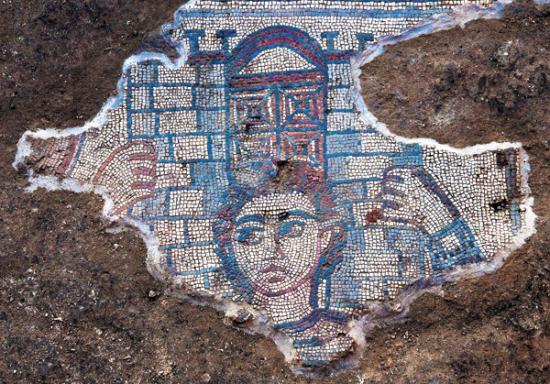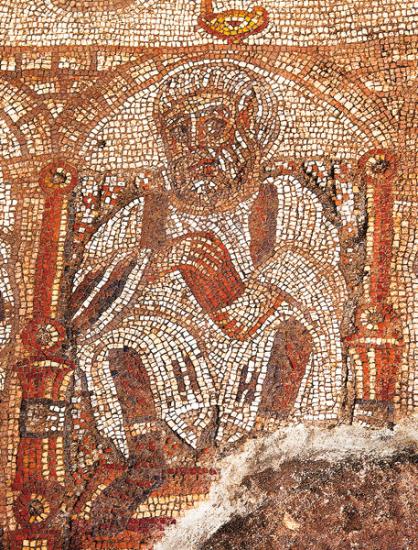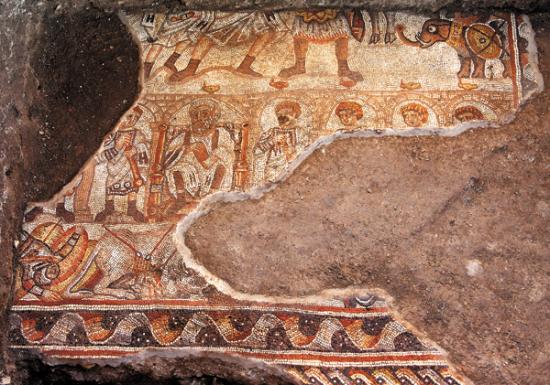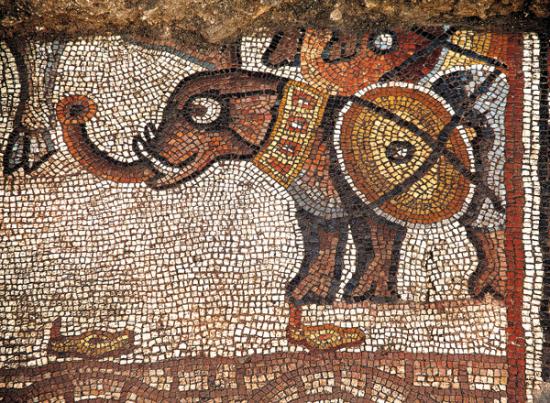Jodi Magness
Source - http://members.bib-arch.org/publication.asp?PubID=BSBA&Volume=39&Issue=5&ArticleID=9

Samson carrying the gate of Gaza on his shoulders, a mosaic found at the Huqoq synagogue. Jim Haberman
Can you hit the jackpot twice in a row? Not likely. But we did!
In the January/February 2013 BAR, we reported on the extraordinary finds uncovered in our excavation of the fifth-century C.E. Huqoq synagogue in Galilee. We thought that would be it at least for a while.
But here we are to update you on the 2013 season—with photographs of the new synagogue mosaics.
Another Samson was found south of the one featured in our previous article. In this one Samson is carrying the gate of Gaza on his shoulders (above), as related in the Biblical text. The gate is paneled. Samson’s hands steady the gate on his shoulders:
At midnight [Samson] rose up, took hold of the doors of the city gate and the two posts, pulled them up, bar and all, put them on his shoulders, and carried them to the top of the hill.
(Judges 16:3, NRSV)
Below a break in the mosaic, the lower part of Samson’s body is preserved, with a red belt around his waist and a red cloak behind his back. Adjacent to Samson are one or more riders with horses, apparently representing Philistines.

Mosaic fragments found at the Huqoq synagogue. Jim Haberman
The discovery of two Samson scenes in the Huqoq synagogue suggests that it was decorated with a Samson cycle according to our mosaic specialist Dr. Karen Britt.
It may surprise some BAR readers to learn that Samson is not described as a giant in the Bible. Samson’s giant stature reflects later Jewish traditions about the Biblical judge and hero, which considered him as a potential (and failed but not false) messiah—a forerunner of the true messiah.
In the period after the Roman destruction of the Temple in 70 C.E. many rabbis disapproved of Samson because of his sexual exploits with non-Israelite women. Another thing the rabbis may not have liked in the Samson mosaics is the Philistines with horses, as this feature is a later elaboration, not a part of the Biblical account. The appearance of these elements at Huqoq (and at the nearby synagogue of Wadi Hamam) may reflect popular Jewish traditions that circulated outside of rabbinic circles.
Another mosaic, released here for the first time, is divided into three horizontal registers (strips), one above the other, each containing figured scenes. It was found in the synagogue’s east aisle. Beginning on the left, the top register shows three men clothed in tunics and mantles marked with gammata or gammadia (here the Greek letter eta [H], a symbol of unknown meaning that sometimes appears on clothing of this period).

A large seated elderly man holding what appears to be a scroll, detail of a mosaic found at the Huqoq synagogue. Jim Haberman

A mosaic featuring three horizontal registers, each containing figured scenes. Jim Haberman
They grasp sheathed daggers and are moving toward a dark-skinned soldier standing in the center. The forelegs of an animal with cloven hoofs are visible to the right of the soldier. Further to the right stands an elephant with a decorated collar or harness, and shields tied to his sides. His trunk is raised, and his eye is large and prominent. Part of another elephant is visible behind the first elephant.

Detail of a mosaic found at the Huqoq synagogue. Jim Haberman
The register below this shows an arcade with lighted oil lamps above the arches; five of them are preserved. Each arch frames a single figure: young men grasping the hilts of sheathed swords. They are arrayed around a large seated elderly man who holds what appears to be a scroll.
Although all these figures wear tunics and mantles with gammata, they are differentiated by details in their hairstyles.
The bottom register shows a bull pierced by spears with blood gushing from his wounds and a fallen and bleeding soldier grasping a shield.
The registers are enclosed by a delicate wavy ribbon pattern near the bottom.
Alas, the meaning of this mosaic is obscure. It has no parallels in other ancient synagogues. Maybe some BAR readers will have suggestions. Dr. Matthew Grey and Dr. Chad Spigel, area supervisors in the squares where this mosaic was recovered, believe that the combination of military themes, elephants, lit oil lamps and the gray-haired man surrounded by young men indicates that they might represent a conflation of the Maccabean revolt, martyr and miracle traditions all celebrated in the Jewish festival of Hanukkah and described in the apocryphal Jewish books of Maccabees. These books contain numerous stories of Jewish heroism and deliverance in connection with battle elephants (see 1 Maccabees 3:32–36; 6:28–46; 2 Maccabees 11:1–12; 13:1–17; and 15:20–28). If these scenes in the mosaic are connected with Maccabean traditions, it would be the first known depiction of an apocryphal (non-Biblical) story in an ancient synagogue.
Admittedly, the connection of this mosaic scene with the Maccabees is speculative; it is equally possible that these scenes have nothing to do with the Maccabees and that the elephants are simply part of a triumphal procession. Our research and analysis are just beginning. We anticipate receiving guidance in future excavation seasons at Huqoq.
The mosaics have been removed from the site for conservation, and the excavated areas have been backfilled. We look forward to continuing our excavations at Huqoq in summer 2014.